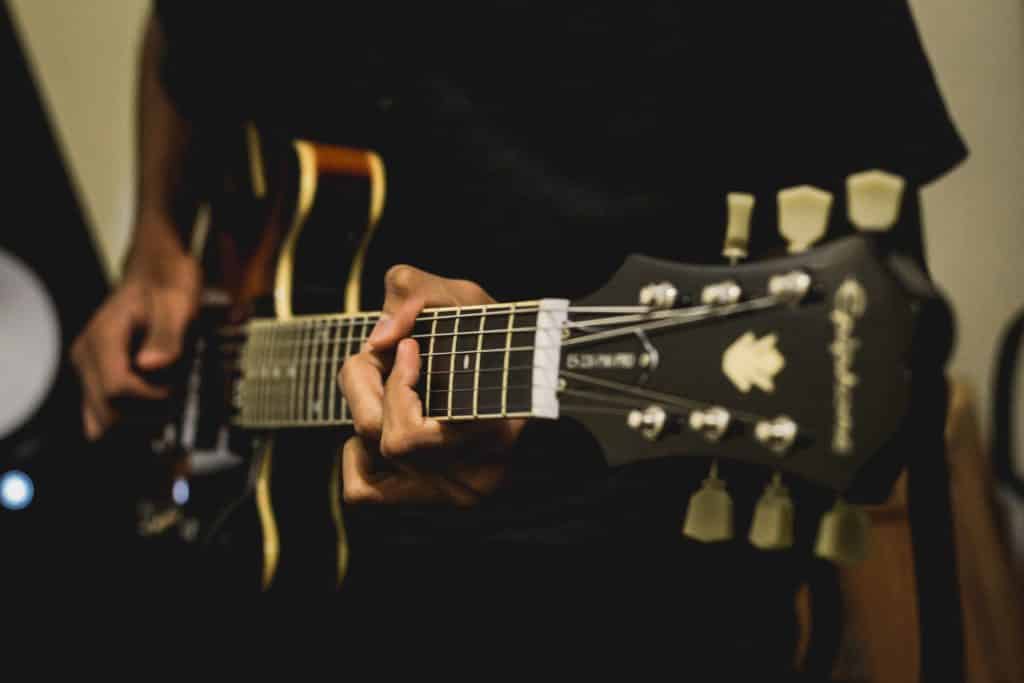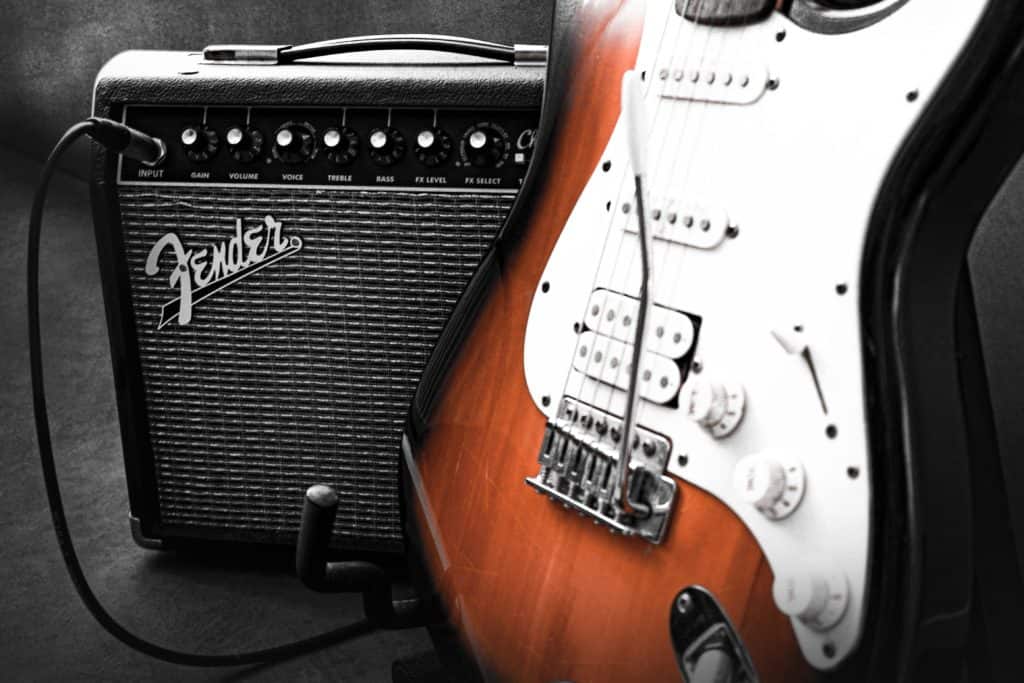
There are several reasons why a band or guitarist would change guitars during a show. Understanding what motivates different aspects of live music can deeply enrich the experience the next time you see your favorite band.
Why do bands change guitars during shows? Bands change guitars to quickly utilize different tunings, variations in tone, and to make small adjustments (like changing a broken string). Alternatively, some guitars just sound better for a specific song or style of music.
Of course, not every guitarist needs multiple guitars. And it may not always be obvious why a band would opt for a certain guitar over another, but the added benefits of changing guitars are clear. Keep reading if you’d like to find out why.
To Quickly Utilize Different Tunings

The tuning of a guitar refers to the pitches assigned to its strings. Different tunings are used to extend the range of notes or chords that can be played.
Entire genres of music can revolve around specific tunings, like American folk or post-hardcore.
Beginning guitarists typically use Standard tuning (E-A-D-G-B-e) as a foundation and later make variations in pitch in order to play other styles or genres of music.
Changing the tuning of a guitar usually requires a highly trained ear or reference note from another source. The guitarist then twists the tuning pegs to raise or lower the pitch of each individual string.
Digital tuners, “stompboxes” and smartphone apps have simplified the process of tuning, but even with modern technology, drastically changing the tuning of a guitar can still be somewhat tedious and time-consuming.
How to Tune a Guitar
For a band that might be trying to minimize the amount of time spent between songs — switching to another guitar, is much quicker than tuning the one you’ve got.
If you want to fit a long set-list into a short set-time, reducing the time between songs is critical.
If the set-list that you’re playing includes multiple tunings — having guitars that are in those tunings is an effective and efficient way to streamline your performance.
Bands like The Beatles, The Rolling Stones, and Led Zepplin were popular before digital tuners existed. In order to play their eclectic set-lists, these bands needed to have multiple guitars pre-set to various tunings.
Jimmy Paige didn’t have time to re-tune every string on his guitar after every song (although people probably still would have paid to watch him do that). Simply switching to a different guitar was just faster.
Until guitars gain the technology to perfectly tune themselves at a moment’s notice, changing to another guitar will always be quicker and simpler than changing its tuning.
Using The Same Tuning
Alternatively, tuning can also be the reason why bands don’t switch guitars.
One of my favorite guitarists, Tim McTague of UnderØATH said that on their Rebirth Tour they didn’t need to change guitars because they played two back-to-back albums with the same tuning.
“We literally only had one guitar because it was all in Drop D,” he said.
Also, many bands will take the time to re-tune a guitar between songs because they don’t have access to an arsenal of guitars. They don’t switch because they can’t switch.
There’s nothing wrong with taking a moment to quickly change tunings — most bands do. It can be a great opportunity to show that you’re human and simultaneously interact with the audience.
For Variations In Tone

This could easily be the longest and most complicated section of this post. But simply put, different guitars have different sounds.
Many bands will change guitars simply because one guitar sounds better than another on a particular song.
Most think this just comes down to personal preference and taste, but there are some cases where a certain guitar is just a better choice.
An extreme example would be the difference between an acoustic guitar and an electric guitar. They look, sound, feel and play extremely different from one another. But many guitarists need both to utilize different styles of music.
James Hetfield of Metallica often performed with a stand that held an acoustic guitar in place while holding his ESP MX220 around his neck. He’d play the acoustic, take a step back, and switch guitars.
This allowed the band to access a more dynamic range and satisfy the “purist” in all of us. The big moments were always exciting and the more intimate moments could be stripped down and quiet.
That’s why there are multiple manufacturers and countless variations of both acoustic and electric guitars.
From Gibson to Fender (and dozens of others), guitars aren’t all created equal and don’t all sound the same. We’ll walk you through a couple of common differences.
Pickups

Guitars are made using different materials. Different hardware, like pickups (which capture the vibrations of the strings) will dramatically affect the way a guitar will sound.
The humbucker is a double coil pickup that produces a thicker overall sound than single-coil pickups, and reduces most background noise or “hum.” The design is essentially two single-coil pickups, wound together in opposite directions, to produce hum cancellation.
Largely because of the fuller, bass-heavy sound from humbucker pickups, Les Paul guitars are extremely popular in hard rock and heavy metal music.
Bridges
Some guitars have fixed bridge systems (also referred to as “hardtails”) and others utilize tremolo bridges (which dynamically raise or lower the pitch of the strings).
Choosing one over the other can drastically change the way a guitar is played.

Guitarists like Jimi Hendrix, Stevie Ray Vaughan, David Gilmour, Eric Clapton, and Buddy Guy used Stratocaster guitars to craft a low gain, blues-tone.
Many guitarists still play Stratocaster guitars to replicate that classic rock sound.
A common caveat to this reason for switching guitars would again be technology. Modern effects pedals or “stompboxes” can accurately and effectively replicate the sounds that would typically come from a specific style of guitar.
Music is constantly progressing and so are the instruments that we use to create it.
Check out our resources page to see what bridges, pickups, and other guitar essentials we recommend for chasing that perfect tone!
To Make Small Adjustments
Additionally, being able to quickly switch guitars not only simplifies issues with tuning but also eliminates most technical difficulties, like when a string breaks (or a guitar gets smashed on stage).
Changing to a spare guitar is quicker and more subtle than de-railing the performance to replace a string.
Mark Yates of TerrorVision tours with two identical Les Paul guitars. He routinely swaps the instruments with the band’s guitar tech so both guitars are always kept perfectly in check throughout each performance.
Having duplicates of the same guitar means there’s always a backup plan in case anything goes wrong.

I used to play in a band called Lucky Mint. We were a three-piece band with only a guitar, drums and a back-track of synthetic pop sounds behind our vocalist.
At one of our first shows, I broke a string and I didn’t know how to play the rest of our songs without it. Without any other instruments, we couldn’t.
It was impossible to continue the show without a guitar.
If I’d had a spare guitar, tuned up and ready to go, we would have been fine, but I didn’t.
Fortunately, a guitarist in one of the other bands came to our rescue and let me play his, saving us from cutting our set short (and disappointing the three kids who’d come to see us play).
It was a lesson in preparation that I’ve never forgotten.
At every show we played following that experience, I made sure to have at least one spare guitar, ready to go in case of another small emergency.
Consequentially, many bands will routinely change guitars to prevent situations like mine from happening.
It’s Just Personal Preference
Ultimately, it just comes down to preference.
Switching to a Les Paul from a Stratocaster might look cool, but unless you’re chasing a thicker tone, it’s not going to sound much different to anyone but you.
For seasoned guitarists that travel the world playing music, having a small collection of guitars to bring on tour is a deliberate decision.
From variations in tone and hardware to just having a spare in case something breaks — bands change guitars in order to streamline their performances and keep things sounding “tight” on stage.
Whatever the reason, one thing is usually always true: switching guitars won’t make you sound better unless you know what you’re doing.
Related Questions
Why do musicians smash their guitars? Musicians smash their guitars on stage because they can. Guys like Jimi Hendrix and Kurt Cobain had money they didn’t know what to do with — so for theatrical purposes, they smashed a guitar every night. In some cases, a musician might be angry, like when Billie Joe smashed his guitar at the iHeart Radio Music Festival after Greenday’s set-time got cut short. But smashing instruments goes way back — for many it was a protest, a way to demonstrate intolerance of political and cultural dogma. It also looks cool and is fun to watch, so that probably has something to do with it.
Why do guitarists use pedals? Guitarists use pedals to enhance or change particular sounds. Distortion, delay, reverb, and gain are all popular effects that guitarists will use to boost the sound of their instrument and give it an exciting twist. There are also very practical pedals like compressors, volume and tuning pedals that serve a specific purpose. It’s an extremely personal way to customize the sound of your guitar and have complete control over the instrument in your hands.
Why do some guitars have two necks? Having two necks on the same guitar is basically like having two guitars. It allows the guitarist to switch quickly back and forth between two guitar sounds. One neck might have 12 strings, the other might have only six. One might have a lot of distortion, the other might have a cleaner tone. Again, it just comes down to preference and what the artist/guitarist wants to accomplish.
For more industry tips and music marketing hacks, check out Ennui Magazine. You can also follow us on Facebook, Twitter, Instagram, Pinterest, and YouTube.
